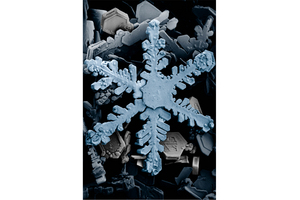Classifying snowflakes is a matter of convention. There is no objective taxonomy; different people have devised different systems of classification for snowflakes, and they have caught on and been used by others to varying degrees, but one’s no more “correct” than another.
One of the first serious attempts to divide snow into different types came in 1951. The International Commission on Snow and Ice devised a classification system of ten types of solid precipitation, of which seven are snow. (The others are graupel, ice pellets, and hail.) This system is still commonly used.
The seven types of snow, according to the Commission, are capped columns, columns, needles, plates, spatial dendrites, stellar crystals, and a miscellaneous category called “irregular forms” for snowflakes that do not fit any of the other types.
A snowflake starts as an ice crystal formed around a small particle of dust in the air. The crystals are commonly six-sided and symmetrical, because water molecules have six sides and when water freezes it tends to grow in six directions. As the crystals fall to earth, they clump together with other crystals. These clumps are snowflakes.
The formation of the crystals, and the way they come together and form snowflakes, is determined by temperature, wind, the amount of water vapor in the air, and the length of time the snowflake falls. These factors determine which of the six patterns-or the “none of the above” irregular forms-the snowflake will follow.
Since the Commission produced its categories, other systems have been devised and are in use in certain quarters. Typically their devisers have sought a more sophisticated classification system that divides snowflakes into far more types than just seven.
Ukichiro Nakaya, a Japanese physicist who was the first person to make snow, studied snow and worked on different classification schemes from the 1930s to the 1950s, eventually coming up with 41 types of snow. Japanese meteorologists C. Magono and C. W. Lee then further subdivided some of Nakaya’s categories, producing a classification system with 80 different types of snow in 1966.
In recent times, Kenneth Libbrecht, a physicist on the faculty of the California Institute of Technology who has traveled the world studying snowflakes, has come up with a classification system with 35 types. Libbrecht’s system too has gained its followers. In 2006, the United States Postal Service issued a set of snowflake stamps, making use of Professor Libbrecht’s photographs of snowflakes.
Incidentally, what about the common belief that “no two snowflakes are alike”? True or myth?
Very likely true, but in a fairly trivial sense. Of course there is no law of nature that somehow prevents two snowflakes from being identical. And it’s not as if someone has actually looked at every snowflake that’s ever fallen in the history of the planet and compared them all with each other and ascertained that no two were the same. But given how many molecules there are in a snowflake, the number of possible forms a snowflake could take is almost unimaginably high. It’s so high in fact that even with all the snow that’s fallen in history, it’s still exceedingly unlikely that any two snowflakes have ever been identical.
It’s not impossible; it’s just strongly against the odds mathematically.
Sources:
Sara Goudarzi, “Photos Show It’s True: No Two Snowflakes Alike.” Live Science.
Kenneth Libbrecht, “A Guide to Snowflakes.” Snow Crystals.
“Snowflake Exercise.” Wilson A. Bentley.


